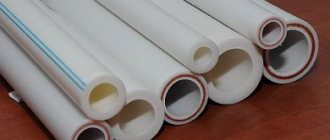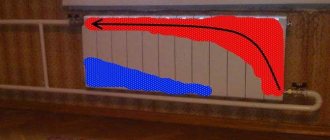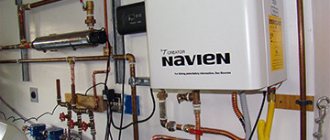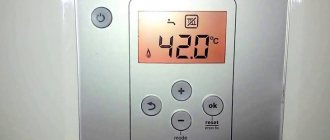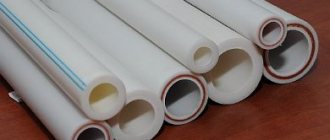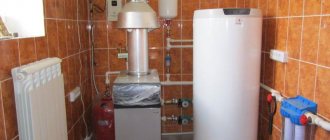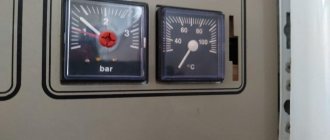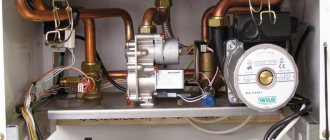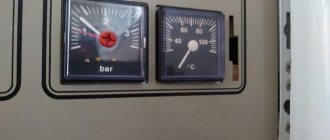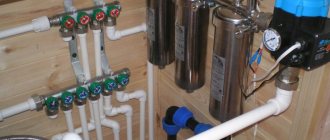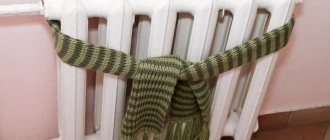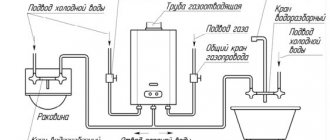What temperature can polypropylene pipes withstand?
To determine the purpose of a polypropylene pipe by appearance, there is a special marking. In addition to the manufacturer and brand name, the generally accepted classification is applied to the pipe.
- name of modification of polypropylene;
- standard proportional ratio;
- nominal outer diameter and wall thickness;
- nominal pressure;
- manufacturer's standards.
The maximum temperature of PP pipes is 95° C. This is perhaps the only drawback of polypropylene; it cannot withstand high temperatures. At 140° the material becomes soft and easily deforms, and at 175° it melts.
The temperature in heating systems is also not designed for such indicators, so PP pipes are quite suitable for use for heat pipes.
Short-term increases in temperature rarely lead to failure, but it is important to take into account that operating pipes at temperatures of 100° significantly reduces their service life.
The 50 years declared by the manufacturer can actually turn into a year and a half, because durability depends not only on its technical characteristics, but also on operating conditions.
We recommend that you read: Polypropylene pipes for heating systems
Who to trust with pipeline installation
The performance of the entire pipeline depends on the quality of installation, so installation work should be carried out by professionals. They will design and calculate everything correctly, while taking into account the temperature conditions of the future pipeline. Only experienced specialists know what pressure polypropylene pipes are designed for, and what pipe diameter is most suitable in a particular case. It is worth noting that the companies provide a guarantee for all work performed. If something breaks or leaks, you will receive help quickly and free of charge. This is especially true in winter.
Plastic pipes ⌀ 20 mm are most in demand among professionals today. When choosing independently, users do not know what pressure a 20 mm polypropylene pipe can withstand. Such products are capable of working with a liquid pressure of 2.0 MPa. This is quite enough for arranging heating and hot water supply.
Polypropylene pipes have many advantages. However, they also have disadvantages that must be taken into account when selecting materials for pipelines. If you follow all operating instructions, polypropylene water supply will serve you flawlessly for many decades. The most important thing is to install plastic pipes and components only from well-known, trusted manufacturers. If a plastic pipeline is combined with a metal one, it is advisable to install cleaning filters. This will protect the system from various impurities.
Pressure and temperature
The manufacturer determines the service life of a polypropylene pipe to be 50 years. The pressure level and temperature of the working environment are important indicators on which the durability and reliability of polypropylene pipes depends.
The higher t, the lower the pressure level should be. The permissible pressure for operating a PP pipe is 30 kg/cm2, but such indicators at high pressure can be critical. In polypropylene pipes, the operating pressure level should still not exceed 10 kg/cm2.
Important! Ideal conditions for PP pipes to serve as long as possible are that the temperature of the liquid should not be higher than 70° at a pressure of 4-6 atmospheres.
Conclusion
Polypropylene (general designation - PP) is today the most common material for the manufacture of water pipes. This “popularity” is due to a number of factors:
- Low cost, which allows significant savings when installing a water supply system.
- Easy soldering, making it possible to do the installation yourself.
- Long service life, reaching over 50 years.
But the main property of polypropylene, which distinguishes it from many other polymers, is excellent thermoplasticity. That is, when heated, this material can easily transform into a soft state, and when cooled, it can harden again. Thanks to this, the simplicity of assembling water supply systems from PP pipes is achieved: the ends of the parts are simply heated and connected to each other using special couplings, or by direct joining.
As you can see, PPR pipes are best suited for cold water supply. But if necessary, they can also be used for hot water. In this case, attention should be paid to the marking, since the maximum operating temperature of polypropylene pipes directly depends on their production technology.
The popularity of polypropylene pipes for use in the laying and installation of water supply and heating networks has grown significantly in recent years. The reliability and durability of the system is perhaps the main criterion when choosing pipes from this material. However, the question of what temperature this material can withstand in heating systems deserves a separate discussion.
Why do you need pipe reinforcement?
To ensure a sufficient level of heat in apartments, it is necessary to turn on the return pipeline and increase the water temperature to 10 ° C. At close operating temperatures, simple polypropylene pipes begin to lose their properties and, in addition, a linear expansion of their dimensions is possible.
This is especially important when laying pipelines with high temperatures in a concrete screed. There is a possibility of concrete cracking and breakdown of the entire heating system. To reduce this effect and completely eliminate it, polypropylene pipes are reinforced.
Reinforcement is the strengthening of the load-bearing capacity of the base material of a product with another material that has a higher level of strength. This increases the ability to withstand temperature changes. Reinforced pipes fully comply with the standards of the heating system, and do not deform when it increases significantly.
The following materials are used to reinforce polypropylene pipes:
- aluminum foil applied to the surface;
- the inner layer of aluminum located along the entire diameter of the pipe, closer to the outer surface;
- fiberglass inner layer;
- inner layer combining fiber and glass fibers.
Aluminum and fiberglass cost about the same. The price mainly depends on the parameters of the pipe itself and the manufacturer. Nevertheless, fiberglass reinforcement has a number of advantages over aluminum:
- no cleaning of the pipe edge is required during installation;
- short time for soldering joints (as with unreinforced pipes);
- there is no internal delamination due to the fusion of glass fiber into polypropylene;
- the strength of the product increases.
We recommend that you read: Polypropylene pipe reinforced with fiberglass - a guarantee of reliability
There is only one drawback of fiberglass - the linear thermal expansion of pipes reinforced with glass fiber is 6% higher than that of pipes reinforced with aluminum.
A little history
At the end of the Soviet era, despite the global shortage, microdistricts of houses were built in the regions of the Far East according to a standard design, popularly called Leningradsky.
During the construction of these houses, an attempt was made to reduce the cost of construction. The walls of the houses were made of panels, but the windows were triple glazed. The heating devices are convectors of a strange design, a curved pipe with an internal diameter of no more than 20 mm with thin steel plates tightly strung on it.
The Far Eastern climate is harsh, with winter temperatures dropping below -30⁰C. When there is a strong wind, the heat loss of a panel house becomes simply enormous and tiny convectors, designed for completely different operating conditions, simply cannot cope with the task. In order to somehow compensate for heat loss, it was necessary to increase the temperature of the coolant beyond 100⁰С, fortunately the parameters of the heating mains allowed this.
Unfortunately, many residential buildings do not have an automated water supply control system. And the prospects for its appearance are vague. When the outside temperature drops to 35⁰C, the thermal power plant, to maintain the temperature regime, raises the coolant readings to 130⁰C. Thanks to pressure, water continues to flow through the pipes, not steam (about
The use of polypropylene pipes in the heating system
In municipal and private heating systems, the most popular are reinforced polypropylene pipes PN20 (working temperature - 60°) and PN25 (working temperature - 95°).
Their increase in price due to reinforcement compared to solid polypropylene pipes is not so great in comparison with their service life and quality. When replacing an old and probably rusty water supply system, the question of choosing between metal and plastic is practically no longer an issue.
The main thing is to choose the right type of polypropylene pipe in accordance with its purpose: hot or cold water supply; heating and temperature variation in winter and summer at the installation site; requirements of building codes and regulations.
And don’t forget about checking the quality of the pipe. It should not have visible inclusions, bubbles or delaminations.
Get to the point
From a practical point of view: the author does not know of a single reliable case where a polypropylene water supply would leak after assembly.
Seriously and for a long time
This does not mean at all that there are no such cases with polypropylene water pipes, but at least some statistics are available.
Let's summarize everything we know.
- Where polypropylene pipes are located, the operating temperature should ideally not exceed 95 C.
- Polypropylene pipes for hot water can tolerate short-term slight excesses of the maximum temperature declared by the manufacturer without visible problems.
Advice: with a slight difference in price, you should still prefer reinforced polypropylene. Just for general reasons.
Good luck with the renovation!
Did you like the article? Subscribe to our Yandex.Zen channel
Soldering process
Two prepared parts - a fitting and a pipe - are placed on heated nozzles. After holding them for the specified time (it is different for each type of pipe), the elements are connected. It is very important to note that the fitting is heated from the inside, and the pipe from the outside. Next, you need to slightly rotate these elements relative to each other so that the molten plastic from the two surfaces mixes and becomes one. It is recommended to do this as quickly as possible before the material begins to crystallize. Well, if everything is done correctly, then we get a one-piece monolithic connection.
Experts recommend additional cooling time and paying special attention to thin-walled elements.
The thing is that when heated and soldered, they are easily deformed for a long time. Therefore, it is advisable to leave the connections alone for 20-30 minutes (it all depends on the ambient temperature).
